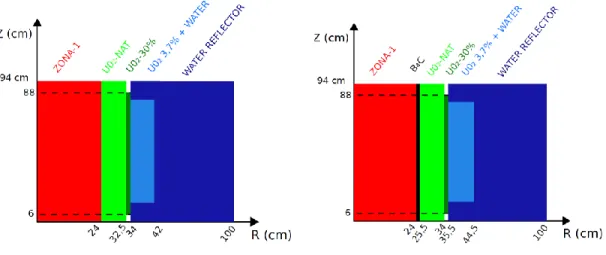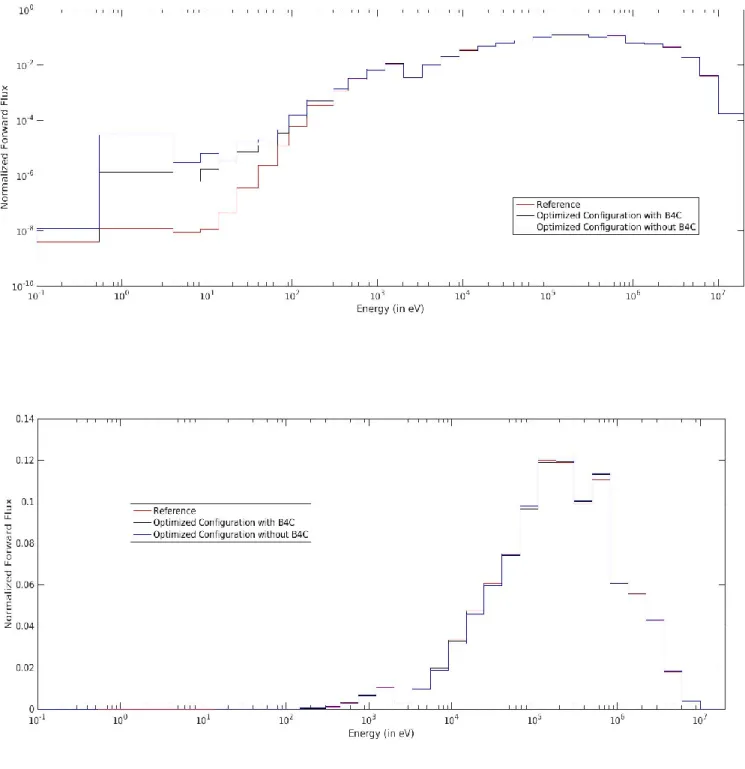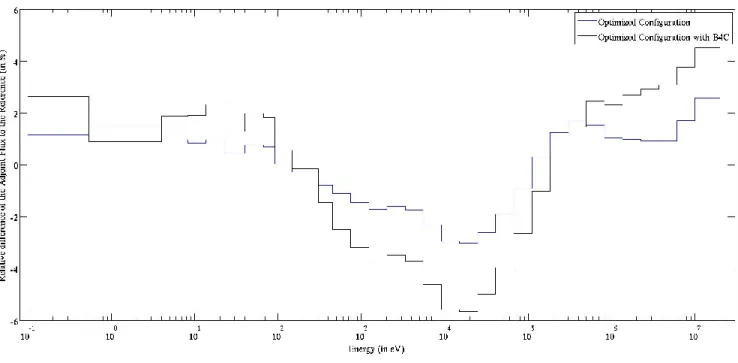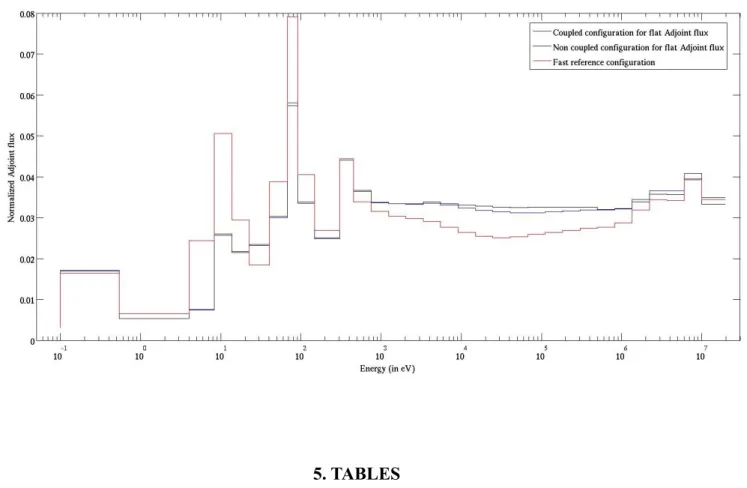HAL Id: cea-02431821
https://hal-cea.archives-ouvertes.fr/cea-02431821
Submitted on 8 Jan 2020HAL is a multi-disciplinary open access archive for the deposit and dissemination of sci-entific research documents, whether they are pub-lished or not. The documents may come from teaching and research institutions in France or abroad, or from public or private research centers.
L’archive ouverte pluridisciplinaire HAL, est destinée au dépôt et à la diffusion de documents scientifiques de niveau recherche, publiés ou non, émanant des établissements d’enseignement et de recherche français ou étrangers, des laboratoires publics ou privés.
Fast-thermal coupled cores in ZPR revisited physical
specificities and potentialities for ZEPHYR
P. Ros, P. Leconte, P. Blaise, J. Di-Salvo
To cite this version:
P. Ros, P. Leconte, P. Blaise, J. Di-Salvo. Fast-thermal coupled cores in ZPR revisited physical specificities and potentialities for ZEPHYR. PHYSOR 2016: The Physics of Reactors conference, May 2016, Sun Valley, United States. pp.ISBN: 978-0-89448-726-2. �cea-02431821�
FAST-THERMAL COUPLED CORES IN ZPR REVISITED
PHYSICAL SPECIFICITIES AND POTENTIALITIES FOR ZEPHYR
Paul ROS, Pierre LECONTE, Patrick BLAISE, Jacques DI-SALVO
CEA, DEN, DER, Cadarache Saint-Paul-Lez-Durance, F-13108, France
paul.ros@cea.fr
ABSTRACT
The development of fast reactor GEN-IV technology at an industrial scale would need a significant improvement of nuclear data and related uncertainties. For this purpose, fast/thermal coupled configurations performed in MINERVE during the 1970’s have been recently revisited. The encouraging results obtained have led to further optimizations in order to prepare experimental programs in the future ZEPHYR facility to be built in Cadarache. This paper describes the concept of fast/thermal coupled core and its use in the improvement of fast-spectrum nuclear data thanks to integral experiments. An optimized configuration is presented with several variations in order to widen the possibilities of measurement so as to separate reactivity effects due to absorption and scattering reactions.
Key Words: experimental mock-up, fast/thermal coupled core, spectral emphasis,
spectral conversion, nuclear data.
1. INTRODUCTION
For the last decades, the MINERVE ZPR located in Cadarache has produced a large range of experimental data, mainly for LWRs but also for the fast spectrum reactors through the PHENIX and SUPERPHENIX projects [1,2]. Nevertheless, due to its fifty operational years and the need to meet the post-Fukushima safety requirements, the CEA and its industrial partners have decided not to update it. The design of a new facility in Cadarache, called ZEPHYR for Zero power
Experimental PHYsics Reactor [3], started with the associated research on future experimental
programs. In parallel with R&D studies about GEN-IV sodium fast reactors, in particular the ASTRID technological demonstrator, a new interest for fast-thermal coupled cores has risen up. Those configurations consist of getting fast-spectrum neutronics characteristics in a reduced central zone, also called the “measurement zone” or “experimental zone” while criticality is achieved thanks to a thermal driver zone. As this latter gathers the majority of fissions, such configurations allow an important reduction of fissile materials and a higher flexibility due to the thermal-spectrum kinetics parameters. The main issue is then to provide a proper fast spectrum in the center thanks to an adapted spectral conversion zone, surrounded by the thermal spectrum zone. Such cores were studied in STEK [4], RB [5] and in MINERVE, through the ERMINE programs in the 1970’s and 1980’s for instance [2]. Their performances and representativity have recently been reevaluated through recent re-interpretation analyses, which demonstrate the relevance of such coupled configurations for nuclear data enhancement. Studies on fast/thermal coupled core design have then started again in order to define dimensional characteristics for ZEPHYR, to get a deeper knowledge
of the neutronics specificities, especially for the spectral conversion and transition zones, and finally to integrate innovative experimental techniques.
This paper describes preliminary results on the physical particularities of coupled cores inspired by the previous cores loaded in MINERVE, leading to an optimized configuration in (R,Z) geometry. Moreover, the spectral emphasis technique is described so as to separate reactivity effects in integral measurements, and adapted configurations are described.
2. PHYSICAL SPECIFICITIES OF COUPLED CORES 2.1. Tools for Fast-Thermal Coupled Cores Studies
In order to understand the neutronics specificities of fast/thermal coupled cores, simplified calculations were performed using the fast-lattice deterministic ECCO/ERANOS system of codes [6]. It enables an accurate calculation of the fast zone - the one of interest - whereas the thermal zone is also well computed thanks to a 1968-group cell calculation based on subgroups and probability table methods for self-shielding. Core calculations are performed in (R-Z) geometry using the BISTRO transport code in S4-P1 and 33 energy-groups.
The relevance of fast/thermal coupled cores depends on the spectral adaptation: is the targeted fast spectrum well reproduced in the center of a coupled configuration? That’s why core performances are evaluated by comparison to an entire fast configuration, which stands as the reference case. This one is entirely made of the fast cell used in the center of the fast-thermal coupled configuration. The uniform fast core is critical by an adaptation of its radius. The comparison is based on spectral indices covering the fast, epithermal and thermal energy range. A 7-energy-group division (recommended in [7]) and the energy profile of the adjoint flux are also used. All indicators are evaluated in the centers of the coupled and the fast-reference configurations.
2.2. The Fast Cell
The fast cell was used in the ERMINE V program, in the center of the ZONA-1 core [2]. It represents an intermediate spectrum, between the two cores of PHENIX. This cell is made of 6 enriched MOx rodlets, 2 natural UOx rodlets and 8 sodium pellets and is 12 inches high and about 2 inches large (from the MASURCA facility). A representation of the ZONA 1 cell is proposed on Figure 1.
This choice influences the composition of the adaptation zone but does not change the neutronics specificities of fast-thermal coupled cores and related solutions presented hereafter.
2.3. From Thermal to Fast Spectrum: Conversion and Transition Zones
The challenge to convert a thermal spectrum into a fast one requires the design of an adaptation zone. The reference fast cell is not efficient enough to lead to the targeted spectrum within an approximate 35 cm radius zone, which represents the current experimental zone radius in MINERVE. Many calculations have been performed in order to improve the spectral adaptation. It seems that two successive zones with different and specific compositions is a satisfactory compromise:
A conversion zone has to suppress the main part of thermal and epi-thermal neutron flux
coming from the thermal zone so as to get a fast spectrum. Two techniques could be used: on the one hand thermal and epi-thermal capturing isotopes (10B for instance) to cut the low-energy part of the spectrum or fissile isotopes in order to convert efficient slowed-down neutrons into fission neutrons on the other hand. In ZPR, as the fast flux intensity is relatively small, the second technique appears to be more efficient because neutrons from the thermal zone strongly contribute to the criticality. Then, capturing them would highly reduce the coupling benefit and then increase the size and need of fissile fuel of the thermal driver zone. Moreover, it should be more relevant to produce neutrons closer to the central position of the core to maximize the fast neutron flux.
A transition zone stands as a first step to the targeted fast spectrum. Indeed, the conversion
zone produces fission neutrons and still presents residual thermal and epi-thermal neutrons. The conversion zone softens the fission neutrons and cuts off the residual thermalized neutrons. Then, several sizes of various materials with different scattering properties (stainless steel, graphite, natural UO2) were tested. Thanks to its “natural” and “specific” slowing-down power, 𝜉𝛴𝑠 and 𝜉𝛴𝑠⁄ , natural UO𝛴𝑎 2 appeared to be the best candidate. As graphite is a better scatterer than natural UO2 with a very low absorption cross section, it increases the thermal and epithermal flux whereas uranium resonances absorb such neutrons.
The composition of those two zones is quite simple which is a strong argument as far as loading and related errors are concerned.
2.4. Optimized Fast-Thermal Coupled Core
An optimized fast-thermal coupled core was designed thanks to the studies on the conversion and the transition zones. An important difference between the ERMINE cores and the optimized configuration presented here is the composition of the driver zone. The MINERVE reactor’s driver zone consists in highly enriched metallic Uranium/Aluminum plates surrounded by a graphite reflector. In the optimized configuration, low enriched PWR-type UO2 pin cells are used.
The central zone, which is made of ZONA-1 cells [2], is surrounded by a natural-UO2 ring, which stands for the transition zone. The conversion zone is made of enriched UO2 pins for which the enrichment level results from a compromise between availability, performance and cost. A slightly different configuration is also proposed, including a small ring made of a 1/v-absorber (including natural B4C) between the fast cells and the transition zone to get a better adaptation in the low-energy groups. These two configurations are illustrated in Figure 2.
The performances of the optimized configurations in the core centers are quantified through three indicators as mentioned in section 2.1. Usual spectral indices are presented in Table 1. However, it has been noticed that in fast thermal coupled cores spectral indices can be extremely well reproduced without a similar precision for the flux. Indeed, fissions produce high energy neutrons in the conversion zone whose proportion can be hidden by the few remaining thermal neutrons which importance are highly increased due to the 1/v-energy dependence of cross sections. Then, we complete spectral indices comparisons with an evaluation of the forward flux in a 7-group division, optimized for both thermal and fast spectra. Results are presented on Table 2 and are very close to
the fast configuration. A representation of forward spectra of the two optimized configurations compared to the reference one are presented in Figure 3 in 33 group-energy mesh. The configuration with B4C allows to achieve a better adaptation, especially in the intermediate energy range.
In reactivity measurements, the adjoint flux has to be well adapted as well. The difference to the reference adjoint flux is presented in Figure 4.
Moreover, the thermal driver zone still produces the majority of fissions in both optimized configurations (with and without B4C). Indeed, the thermal zone provides 57 % of fissions in the configuration without B4C, whereas the ZONA-1 central zone stands for 12 %. In the optimized one with B4C, 61 % of fissions are provided by the thermal zone and 10 % come from the ZONA-1 zone.
The triple evaluation of the neutronics characteristics in the center of the designed fast thermal coupled cores proves that it is possible to reproduce a fast spectrum in a fast thermal coupled core with a low enriched thermal zone, which is a strong difference with the configurations designed for MINERVE, STEK and RB. Moreover, it turned out that spectral indices are not a sufficient tool to evaluate the spectrum characteristics of such configurations and can be enriched with a 7-group division of the forward flux.
3. SEPARATION OF REACTIVITY EFFECTS: SPECTRAL EMPHASIS TECHNIQUE
In ZPR, highly precise measurement techniques such as pile oscillations enable to achieve uncertainties in the range of 0.01 pcm. Nonetheless, total and integral effects can only be measured. The spectral emphasis technique [8-9-10], relying on the modification of the adjoint-flux energy-dependence, gives a way to separate reactivity effects in integral experiments.
3.1. Principle of the Spectral Emphasis Technique
For a non fissile isotope, the total reactivity variation splits up into two parts: ∆𝜌𝑡𝑜𝑡 = ∆𝜌𝑠 + ∆𝜌𝑎. The perturbation theory, here developed in G energy groups in the diffusion theory, leads to :
∆𝜌𝑎 = − ∑ 𝛷𝑟𝑒𝑓,𝑔† 𝐺 𝑔=1 ∆𝛴𝑎𝑔𝛷𝑝𝑒𝑟𝑡,𝑔 and ∆𝜌𝑠 = ∑ ∑ (𝛷𝑟𝑒𝑓,𝑔′† − 𝛷𝑟𝑒𝑓,𝑔† ) 𝐺 𝑔′=1 𝐺 𝑔=1 ∆𝛴𝑠𝑔→𝑔′𝛷𝑝𝑒𝑟𝑡,𝑔 The main difference between those expressions is the adjoint flux contribution to the reactivity effect. Indeed, whereas the ∆𝛴𝑔𝛷𝑝𝑒𝑟𝑡,𝑔 term is multiplied by 𝛷𝑟𝑒𝑓,𝑔† for absorption, it is multiplied by (𝛷𝑟𝑒𝑓,𝑔′† − 𝛷𝑟𝑒𝑓,𝑔† ) for scattering. Consequently, if the adjoint flux is energy-independent, ∆𝜌𝑠 = 0 and therefore, ∆𝜌𝑡𝑜𝑡 = ∆𝜌𝑎. Using another configuration, with a strong energy dependency of the adjoint flux, we would be able to separate the absorption and scattering reactivity effects.
3.2. Adapted Configurations to Separate Reactivity Effects 3.2.1. Strongly energy-dependent adjoint flux configuration
High energy neutrons have an increasing importance. Then, a way to obtain a configuration with a strongly energy-dependent adjoint flux is to emphasize this tendency from the lowest energy ranges. The natural growth of the neutron importance for low energies can be easily canceled with a 1/v-absorber. Moreover, a fertile zone will re-inforce the high-energy natural increase due to threshold-fission cross sections [7].
A ring of enriched B4C surrounded by one of natural UO2 is placed in the middle of the optimized coupled configuration and of a fast-reference configuration. The results are presented on Figure 5. 3.2.2. Energy-independent adjoint flux configuration
Energy-independent adjoint spectrum can be achieved thanks to a modification of the reference cell. The high-energy increase can be reduced by a moderate use of fertile isotopes, whereas the low energy importance is reduced with 1/v-absorber [8-9]. From those principles, an optimized cell has been designed where MOx fuel has been replaced by 27%-enriched-MOx fuel, B4C and graphite have been added. The results are presented on Figure 6.
4. FIGURES
Figure 1: Fast-cell used in the centers of coupled and reference configurations (ZONA-1 cell)
Figure 4: Difference of adjoint flux in the center of the optimized configurations to the reference
Figure 6: Energy-independent adjoint flux in the center of fast-thermal coupled or fast configurations
5. TABLES
Table 1 : Comparison of spectral indices at the center of optimized fast-thermal configurations
Spectral indices Fast reference Optimized Configuration Optimized Configuration with B4C
) ( )
(238U f 235U
f
3.604E-02 3.601E-02 3.594E-02) ( )
(237Np f 235U
f
2.375E-01 2,379E-01 2,372E-01) ( )
(238U f 235U
C
1.282E-01 1,269E-01 1,275E-01) ( ) (10B f 235U a
1.292 1.313 1.300Table 2 : Comparison of 7-group division of the energy spectrum at the center of optimized configurations
Upper Energy in Group 19.6 MeV 2.23 MeV 498 keV 67 keV 2 keV 22.6 eV 0.54 eV Optimized Configuration
(in %) 6.5 22.8 44.0 24.4 2.2 1.2E-02 5.3E-06
Optimized Configuration
with B4C (in %) 6.6 22.9 43.4 24.8 2.3 9.5E-04 2.6E-06 Fast reference
6. CONCLUSIONS
Recent work on fast-thermal coupled cores, within the frame of the future ZEPHYR critical facility to be constructed in Cadarache, has demonstrated their relevance and performances in terms of spectral conversion. Its optimization based on available fissile and structural materials from CEA critical facilities have led to excellent neutronics characteristics with a PWR-type thermal driver zone. Besides, spectral emphasis could be used as a powerful technique so as to separate reactivity contributions in integral measurements. Those results will be useful to design new experimental programs for the GEN-IV-reactor generation in ZEPHYR. In this context, studies on fast-thermal coupled cores are planned to be extended in two ways. On the one hand, specific experiments from ERMINE programs (oscillations of separated fission products for integral capture cross sections, and irradiation measurements) are currently being re-analyzed and will be presented soon. On the other hand, characteristics for the future experimental programs will be studied: in particular, safety analyses related to accidental flooding will be studied with associated neutronics parades, as well as a pre-design of samples for the oscillation technique in fast lattices.
REFERENCES
[1] S. CATHALAU et al., “More than forty years of neutronics experiments in critical facilities of Cadarache center: from EOLE and MINERVE to the future ZEPHYR reactor”, IGORR conference, Bariloche, 2014
[2] L.MARTIN-DEIDIER, Mesure intégrale de la capture des produits de fission dans les
réacteurs à neutrons rapides, PhD Thesis, Université Paris-Sud Orsay (1979).
[3] P. BLAISE, et al. « The R&D roadmap for Gen-2,3 & IV neutronics studies in the future
ZEPHYR ZPR in Cadarache”, IGORR Conference, Berlin, March 2016.
[4] M. BUSTRAAN et al. « STEK, the fast-thermal coupled facility of R.C.N. at Petten”, RCN-122 [5] M. PESIC, « Coupled fast-thermal system at the « RB » Nuclear reactor », Kernenergie, 80, 4
(1987)
[6] G. RIMPAULT et al. “The ERANOS code and data system for fast reactor neutronic analyses”, PHYSOR Conference Seoul Korea 2002.
[7] G.PALMIOTTI and M.SALVATORES, “Impact of Nuclear Data Uncertainties on Innovative Fast Reactors and Required Target Accuracies”, Journal of NUCLEAR SCIENCE and
TECHNOLOGY, Vol. 48, No. 4, pp. 612 – 619 (2011).
[8] E. LEHMANN et al. « A fast critical reactor assembly with strong energy dependence of adjoint flux”, Kernenergie, Vol. 34, pp. 9-12 (1991)
[9] K. FAHRMANN et al. « A fast-thermal coupled system with energy-independant adjoint flux”,
Kernenergie, Vol. 24, pp. 431-433 (1981)
[10] E. LEHMANN et al. « The method of energy-independant adjoint flux and its perfection by the SEG-V configuration”, Kernenergie, Vol. 29, pp. 30-33 (1986)



